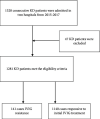Predictors for Intravenous Immunoglobulin Resistance in Patients with Kawasaki Disease
- PMID: 35989868
- PMCID: PMC9365590
- DOI: 10.1155/2022/2726686
Predictors for Intravenous Immunoglobulin Resistance in Patients with Kawasaki Disease
Abstract
Background: Between 10 and 20% of Kawasaki disease (KD) patients are resistant to treatment with initial intravenous immunoglobulin (IVIG) and have a high risk of developing coronary artery lesions. Some studies have been conducted to identify predictive factors. However, the results are controversial. This study aims to identify the risk factors for IVIG-resistant KD patients in a Chinese population.
Methods: We performed a retrospective analysis of medical records of consecutive KD patients from two medical centers in South China from January 2015 to December 2017. A total of 1281 KD patients were eligible for inclusion in this study and maintained follow-up for over 12 months. The KD patients were divided into two groups based on IVIG response. Clinical characteristics and laboratory variables were compared between the two groups. Multivariate logistic regression analysis was performed to identify the risk factors of IVIG resistance in KD patients.
Results: Of the 1281 KD patients, 141 (11.0%) cases who were IVIG resistant to adjunctive therapies for primary treatment were classified as group 1. The remaining patients were in group 2 (n = 1140), classified as the control group. There was a significant difference in male to female ratio and the length of hospital stay between the two groups (P < 0.05). Group 1 had a higher white blood cell count (P=0.01) and C-reactive protein level (P < 0.01) before IVIG treatment than in group 2. Group 1 had a significantly higher white blood cell count and percentage of neutrophils after the IVIG infusion than in group 2 (P < 0.001). In addition, the mean values of C-reactive protein level and neutrophil percentage before and after treatment difference comparison were significantly different. Multivariate analysis showed that patients presenting with coronary artery lesions in the acute phase and a C-reactive protein level >100 mg/L at diagnosis were associated with IVIG resistance in KD. During the 12-month follow-up period, group 1 had an obviously higher incidence of coronary artery lesions than group 2, and the difference between the groups was statistically significant (P < 0.001).
Conclusions: Patients presenting with coronary artery lesions in the acute phase and elevated C-reactive protein levels before IVIG treatment might be a useful and important value for predicting IVIG resistance in KD. Risk assessment based on coronary artery lesions and C-reactive protein levels prior to the treatment may improve the outcome of IVIG resistance.
Copyright © 2022 Wei Li et al.
Conflict of interest statement
The authors declare that they have no conflicts of interest.
Figures


Similar articles
-
Evaluation of laboratory predictors for intravenous immunoglobulin resistance and coronary artery aneurysm in Kawasaki Disease before and after therapy.Clin Rheumatol. 2023 Jan;42(1):167-177. doi: 10.1007/s10067-022-06366-x. Epub 2022 Sep 21. Clin Rheumatol. 2023. PMID: 36129563 Free PMC article.
-
The role of serum lipid in predicting coronary artery lesions and intravenous immunoglobulin resistance in Kawasaki disease: a cohort study.J Int Med Res. 2024 May;52(5):3000605241252115. doi: 10.1177/03000605241252115. J Int Med Res. 2024. PMID: 38713460 Free PMC article.
-
Predictors for intravenous immunoglobulin resistance and coronary artery lesions in Kawasaki disease.Pediatr Rheumatol Online J. 2017 Mar 21;15(1):17. doi: 10.1186/s12969-017-0149-1. Pediatr Rheumatol Online J. 2017. PMID: 28320400 Free PMC article.
-
Higher efficacy of infliximab than immunoglobulin on Kawasaki disease, a meta-analysis.Eur J Pharmacol. 2021 May 15;899:173985. doi: 10.1016/j.ejphar.2021.173985. Epub 2021 Feb 27. Eur J Pharmacol. 2021. PMID: 33652059
-
Neutrophil-Lymphocyte Ratio for Predicting Coronary Artery Lesions in Children With Kawasaki Disease.Indian Pediatr. 2023 Mar 15;60(3):207-211. Epub 2023 Jan 2. Indian Pediatr. 2023. PMID: 36604937 Review.
Cited by
-
Immunophenotype of Kawasaki Disease: Insights into Pathogenesis and Treatment Response.Life (Basel). 2025 Jun 25;15(7):1012. doi: 10.3390/life15071012. Life (Basel). 2025. PMID: 40724515 Free PMC article. Review.
-
Giant Coronary Aneurysms with Multiple Large Resistant Thromboses in an 8-Month-Old Boy with IVIg-Resistant Kawasaki Disease: A Case Report.J Tehran Heart Cent. 2023 Jul;18(3):224-227. doi: 10.18502/jthc.v18i3.14118. J Tehran Heart Cent. 2023. PMID: 38146411 Free PMC article.
-
Predictive factors of medium-giant coronary artery aneurysms in Kawasaki disease.Pediatr Res. 2024 Jan;95(1):267-274. doi: 10.1038/s41390-023-02798-6. Epub 2023 Sep 5. Pediatr Res. 2024. PMID: 37670043 Free PMC article.
-
Bibliometric and visual analysis of Kawasaki disease in children from 2012 to 2022.Front Pediatr. 2023 Jul 27;11:1142065. doi: 10.3389/fped.2023.1142065. eCollection 2023. Front Pediatr. 2023. PMID: 37576134 Free PMC article.
-
C-reactive protein to albumin ratio as a prognostic tool for predicting intravenous immunoglobulin resistance in children with kawasaki disease: a systematic review of cohort studies.Pediatr Rheumatol Online J. 2024 Apr 12;22(1):42. doi: 10.1186/s12969-024-00980-6. Pediatr Rheumatol Online J. 2024. PMID: 38610057 Free PMC article.
References
MeSH terms
Substances
LinkOut - more resources
Full Text Sources
Medical
Research Materials
